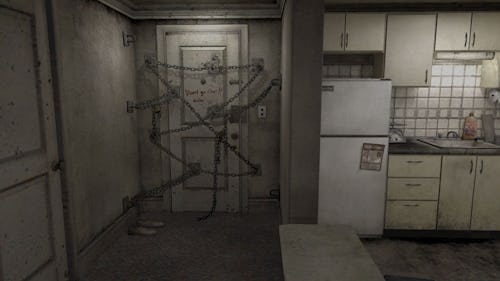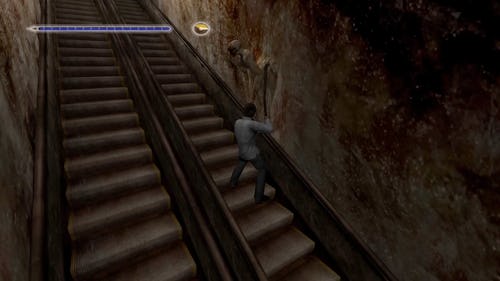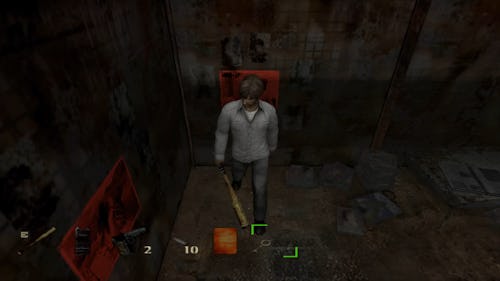
Henry Townshend wakes up one morning to find himself trapped in his own dingy apartment. The front door is mysteriously covered in chains and padlocks, and Henry has no means of communicating with the outside world. That is save for a mysterious hole in his bathroom wall that acts like an evil Mario pipe, whisking him away to nightmarish hellscapes.
Thus begins The Room (no relation to Tommy Wiseau’s 2003 cult classic), the fourth entry in acclaimed survival horror series Silent Hill. While the game is viewed as the black sheep in the franchise, its ambitious gameplay — despite uneven execution of subversive ideas — was a pioneer of contemporary survival horror games that almost managed to outdo the franchise’s biggest rival.
Although Silent Hill 4 isn’t fondly remembered as the most visually impressive or mechanically sound Silent Hill, its introduction of ambitious gameplay mechanics paved the way for how modern survival horror games are designed while also putting Resident Evil on notice (at least for a bit).
Perspective in a not-so-safe saferoom

One of Silent Hill 4’s innovations is its first-person camera inside Henry’s apartment unit. It's here that the game exclusively introduces a first-person perspective — a first for the series. This also came with a horrifying realization: not all rooms for saving your game are rooms where you can find temporary safe haven.
Apartment 302 ostensibly serves as the game’s safe room. Here, Henry can observe the outside world through various holes and windows and survey subtle changes in the layout of his apartment as the game progresses. The room also functions as a means for players to save their game and drop items in an inventory box.
However, apartment 302 can become increasingly antagonistic for players if they unwittingly drop cursed items into their inventory box, thus transforming the safe room into another hostile environment with a medley of hauntings. This nifty departure in gameplay presentation proved so ingenious it wound up being perpetuated in other survival horror games like Dead Space, Outlast, and Resident Evil 4 Remake.
Survival horror combat evolved

Alongside shaking up the cinematic delivery of the narrative via camera angles, Silent Hill 4 also introduced a myriad of gameplay changes to its combat. The first visibly notable change is a visible health bar on the upper left-hand side of the screen display. This addition effectively lampshades this entry in the series, famously regarded as an immersive cinematic experience, as a step toward Resident Evil's action-oriented survival horror vibes.
Another curious visual element to Silent Hill 4’s busier screen is a circular icon to the right of its health bar that denotes the strength of melee attacks. In theory, the gauge — which fills up like a speedometer — allows the player to charge up powerful melee attacks in high-risk, high-reward combat scenarios. In practice, however, a quick volley of faster melee attacks are more optimal in that they stun-lock enemies more effectively. While Silent Hill 4’s melee icon served as a head-scratching addition to franchise formula, its inclusion made the game a tad bit more fluid in the combat department.
We can also credit Silent Hill 4 for bringing us a controversial staple in modern games like The Legend of Zelda: Tears of the Kingdom — weapon durability. As in, the more you fight, the more your weapons tend to break. Much like in recent Zelda games, Silent Hill 4’s approach to varying weapon durability and the on-screen item selection menu forced players to stop and think carefully about risky encounters instead of brute-forcing their way through.
A cult classic legacy

Silent Hill 4’s legacy as a divisive game is less about its story being divorced from both the setting and lore of its predecessors and more about its shoddy execution of its new ideas. A snapshot of Silent Hill's Metacritic scores in 2024 reveals Silent Hill 4 isn’t among the upper echelons of the franchise. In fact, the game is the sixth highest-rated Silent Hill game, sandwiched between Silent Hill: Origins and Silent Hill: Homecoming. (The first three numbered Silent Hill games occupy Metacritic's top three rated spots in the series.)
Whether you see Silent Hill 4 as a great game marred by its execution or a low-point for the series, it's undeniable that its neat tricks served as a harbinger for the state of modern survival horror games. To paraphrase the immortal words of YouTube video essayist NakeyJakey: games that are only 7 out of 10 walk... so that real 10 can copy their ideas later and win a bunch of awards.
FTTT
0 Comments